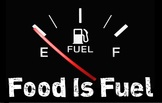Having trouble gaining weight? Chances are that you aren’t getting the right nutrition. It could be as simple as distributing calories more appropriately throughout your meals: (The graphs below show protein intake, but we can relate this with the amount of calories consumed during specific meals).
As you can see in the photo above, our typical diet in the US is far from optimal. Do you fit this graph? If so, try to eat a better breakfast in the morning and distribute calories evenly over the course of the day via meals and snacks. Hopefully, it will look more like this:
Our bodies can be a little finicky when it comes to calories. Too many calories and we feel worn down and lazy, not to mention a little more weight to carry around. Too few calories and we feel worn down and our bodies can’t keep up with our physical demands. Either way, our performance lacks when we don’t have proper nutrition. Take a look:
First off, let’s get some things straight: I don’t claim to be a dietitian. This is a system that worked for me when I played professionally, so I’ll share it with you.
Here’s a couple more facts about nutrition you will need to know:
There are 3,500 calories in a pound.
There are 2.2 pounds in every kilogram.
1 gram of protein is equal to 4 calories
1 gram of fat is equal to 9 calories
1 gram of carbohydrates is equal to 4 calories
Thermodynamics – the amount of calories you burn while digesting your food. Roughly burns around 10% of the calories you consume per day.
Take this formula and plug your own weight to see how many calories you need to consume to just MAINTAIN your current weight, not taking in your activity level. (if you sat on the couch and did nothing all day, which no one does, we hope!)
Body weight (in kilograms) x 24 (hours in a day) x 1.1 for males and 0.9 for females (Thermodynamics)
If you aren’t consuming that many calories, try starting there. The formula below might be too much food for you if you aren’t consuming enough to begin with.
If you ARE eating that many calories, then take this into account:
If you are a VERY active person (professional athlete type training regimen), multiply that number by 200% or 2, it’s safe to say that most of us are not that, so multiple that original number by 180% or 1.8. That will give you the approximate number of calories you should be consuming to maintain your weight safely taking into account your activity level.
Let’s show an example:
We have a 160 pound or 72 kg high school male football player:
(Weight in kilograms (72)) x (hours in a day (24)) x (male thermodynamics (1.1)) = 1,900 calories if he did nothing at all to maintain his weight.
Our football player is pretty active, but doesn’t train for a living so:
1,900 x 1.8 = 3,420 calories
Our football player must consume 3,420 calories per day to MAINTAIN his weight.
Now, our football player wants to gain weight. So, let’s just say he wants to add 1 pound per week. Remember 1 pound is equal to 3,500 calories so divide that by 7 days per week and we need to add 500 calories onto our football player’s daily calorie intake:
3,420 + 500 = 3,920 calories.
Spread that out between 6 meals a day and you are eating 653 calories per meal. Let’s round that down
to 650 to make it easy. To give you an idea of how much 650 calories is: Let’s go with something simple that everyone can relate with
1 – 8oz Grilled Chicken Breast (293 cal)
1 cup – Brown Rice (216 cal)
1 cup – Whole Milk (146 cal)
Remember, our football player would need to eat this a total of 6 times per day every 2.5 hours since as humans, we are normally up for 15-16 hours per day.
Now, obviously we can’t JUST eat a chicken breast and rice all day every day, and we will be missing out on a lot of nutrients if we just eat that every meal. So let’s break it up this way:
1 gram of protein is equal to 4 calories
1 gram of fat is equal to 9 calories
1 gram of carbohydrates is equal to 4 calories
We want to consume roughly 30% protein (195 calories or 48 grams for our football player), 50% carbohydrates (325 calories or 81 grams for our football player), and 20% fat (130 calories or 14 grams for our football player) for our most effective results.
Now, in our Chicken and Rice dinner, we had 15 grams from fat, 56 g from carbohydrates, and 71 g from protein. A little heavy in the protein section and only two thirds of what we need in the carbs section.
So, let’s play around with this a little:
8 oz of chicken breast is a lot, that’s why we were heavy in the protein column. So let’s only eat 4 oz of that chicken breast. Before that chicken was giving us 58 grams of protein, now we are only having 29 grams. But now our calories went down. We are still 70 calories short of our goal and could use some more carbohydrates. Fruits and vegetables are great, especially corn and peas along with potatoes. Those foods are high in good starchy carbohydrates, as well as fiber. Let’s try a sweet potato.
1 – 4 oz Grilled Chicken Breast (147 cal)
1 cup – Brown Rice (216 cal)
1 cup – Whole Milk (146 cal)
6 oz – Sweet Potato (150 cal)
Here’s our final totals for our protein, carbs, and fats: (we did pretty good)
13 grams of fat
92 grams of carbs
48 grams of protein
660 calories
Unfortunately, it’s not just eat this many calories and be set. In order to do it the right way, we need to make sure we are getting the right nutrition and balance of protein, carbohydrates, and fat.
Take this as an example of how to plan out your meals. Start with one day and see how you do. Remember, add in your weight and activity level to the formula.




